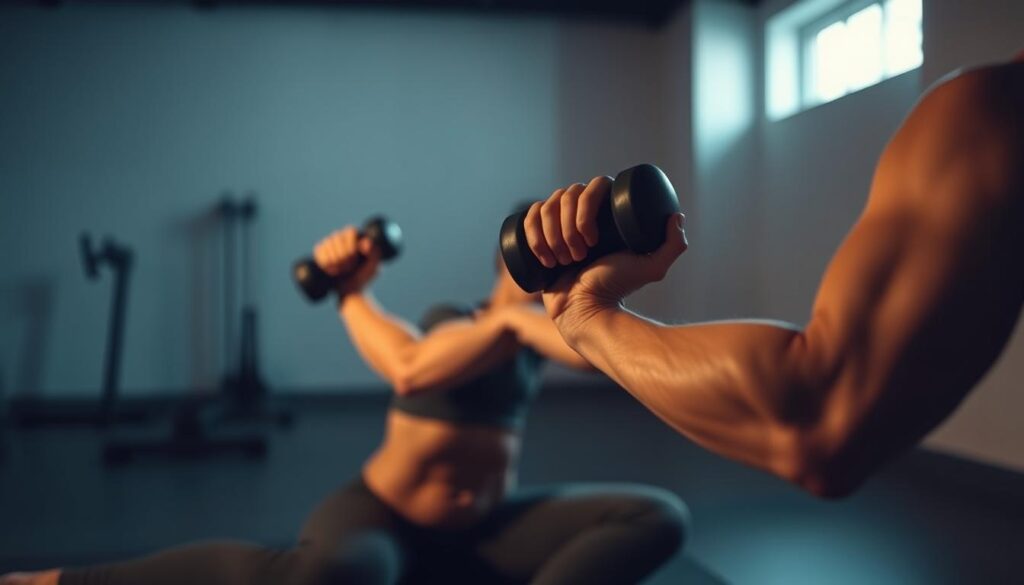Remember the last time you pushed through a workout only to feel stiff or sore afterward? Maybe your knees ached after jumping exercises, or your shoulders burned from repetitive strain. You’re not alone. For many, the idea of getting stronger often comes with visions of heavy weights, pounding pavement, or high-intensity routines that leave joints feeling battered. But what if you could achieve real results without sacrificing your body’s long-term health?
Traditional workouts like squats, resistance bands, and controlled weightlifting are more than just joint-friendly—they’re powerful tools for growth. Research shows these methods can develop muscle and endurance while reducing wear and tear. The secret lies in prioritizing form over speed and focusing on movements that keep one foot grounded or minimize abrupt impacts.
This approach isn’t about settling for less. It’s about working smarter. Trainers and athletes increasingly turn to low-impact routines to maintain progress without setbacks. Whether you’re recovering from an injury or simply want sustainable fitness, these strategies offer a path to lasting gains.
Key Takeaways
- Low-impact methods protect joints while effectively increasing muscle and endurance
- Proper technique transforms traditional exercises into joint-friendly movements
- Resistance training and bodyweight workouts are central to this approach
- Sustainable routines reduce injury risk and support long-term fitness goals
- Experts recommend these strategies for balanced, lasting physical development
Understanding Low-Impact Training
Ever wondered why some workouts leave you energized instead of achy? Low-impact training focuses on protecting your body while building resilience. Unlike high-intensity routines, these methods prioritize sustainable movement patterns that maintain joint health over years.
Defining Low-Impact Exercise
Low-impact workouts minimize forceful contact between your body and surfaces. “It’s about reducing vertical stress while maintaining intensity,” explains physical therapist Dr. Elena Torres. Think cycling, yoga, or water aerobics—activities where at least one foot stays grounded or buoyancy supports your frame. This approach contrasts sharply with running or plyometrics, which generate up to 5x your body weight in joint pressure.
How Low Impact Protects Your Joints
Your knees and hips absorb shock with every jump or sprint. Low-impact alternatives like elliptical training or resistance band exercises distribute force evenly. Controlled motions strengthen muscles around joints without cartilage wear. Over time, this reduces inflammation risks while improving mobility.
Research shows these methods lower injury rates by 37% compared to high-impact routines. By focusing on precision over power, you maintain training consistency—the real key to lasting fitness results. Your body gets stronger, not battered.
The Health and Fitness Benefits of Low-Impact Exercise
Can exercise boost your health without risking injury? Low-impact routines deliver dual advantages—protecting your body while enhancing physical and mental performance. These methods help you maintain consistency, the foundation of lasting results.
Reducing Injury Risk and Enhancing Recovery
High-impact activities like running cause 3x more injuries than cycling or rowing. A Journal of Sports Medicine study found low-impact users took 40% fewer rest days due to soreness. Your joints stay healthier, letting you train more often without setbacks.
This approach also lowers stress hormones. Cortisol levels drop by 18% during controlled workouts, helping muscles repair faster. You’ll notice less stiffness after sessions, making daily movement easier.
Boosting Cardiovascular and Muscular Strength
Rowing machines build endurance as effectively as sprinting—without joint punishment. Try this comparison:
| Activity | Calories/Hour | Injury Risk | Muscle Groups |
|---|---|---|---|
| Cycling | 400-600 | Low | Legs, Core |
| Running | 600-800 | High | Legs Only |
| Resistance Bands | 200-300 | Very Low | Full Body |
Bodyweight exercises like planks increase core strength by 24% in 8 weeks. Endorphin release during these sessions improves focus—30 minutes daily can sharpen mental clarity for hours afterward. Your fitness gains become sustainable victories, not painful sacrifices.
Incorporating Resistance Training into Your Routine
What separates joint-friendly workouts from injury-prone routines? The answer lies in precision over power. Resistance training becomes low-impact when executed with deliberate control—a game-changer for sustainable progress.
Controlled Tempo and Proper Form
Your rep speed matters more than you think. Studies show taking 3-4 seconds per lift phase reduces joint strain by 28% compared to fast, jerky motions. “Rushing through reps sacrifices safety for ego,” warns NASM-certified trainer Mark Rivera. “Your muscles respond better to tension than momentum.”
Keep one foot grounded during standing exercises like overhead presses. This stabilizes your spine and distributes weight evenly. For seated rows, maintain a neutral neck position to avoid shoulder stress.
| Technique | Tempo | Joint Impact | Results |
|---|---|---|---|
| Proper Form | 3-4 sec phases | Low | Strength + Safety |
| Jerky Movements | High | Injury Risk | |
| Partial Reps | Variable | Moderate | Limited Gains |
Consistent routines using weights or bands strengthen bones as effectively as dairy intake—reducing osteoporosis risks by 31%. Your future self will thank you for prioritizing form today. Small adjustments create lasting transformations.
How to Build Strength with Low-Impact Exercises
Ever felt your muscles working harder than your joints during a workout? Strategic modifications let you develop power while protecting vulnerable areas. The key lies in movement precision and intelligent exercise selection.

Step-by-Step Strength Training Techniques
Start with tempo control. A 4-second lowering phase during squats reduces knee strain by 34% compared to rapid descents. “Speed sacrifices safety,” notes trainer Alicia Monroe. “Your muscles respond better to sustained tension.”
Machine-based options offer built-in stability. Leg presses strengthen quads without spinal compression. Shoulder presses using guided rails maintain proper joint alignment. These methods allow heavier loads with minimal risk.
| Exercise | Modification | Benefit |
|---|---|---|
| Lunges | Keep both feet grounded | Reduces knee impact |
| Push-ups | Elevate hands on bench | Decreases wrist strain |
| Deadlifts | Use resistance bands | Protects lower back |
Balancing Resistance and Low-Impact Movements
Alternate loaded and bodyweight days. Perform weighted chest presses on Monday, then switch to incline push-ups on Thursday. This rhythm lets joints recover while maintaining training frequency.
Increase reps before adding weight. Bodyweight squats become more effective when done slowly for 20+ repetitions. Over eight weeks, this approach builds endurance that translates to strength gains.
Combine methods for full-body development. Pair machine rows with resistance band pull-aparts. Your back muscles get dual stimulation without overtaxing shoulders. Consistent, joint-conscious training creates lasting results you can sustain for years.
Designing a Balanced Low-Impact Workout Plan
Struggling to create a workout plan that doesn’t strain your joints? The secret lies in blending activities that challenge your body while respecting its limits. A balanced routine mixes movement types to prevent overuse injuries and keep progress steady.
Integrating Variety for Full-Body Conditioning
Swap repetitive motions for diverse workouts that engage multiple muscle groups. Alternate between swimming, resistance band circuits, and yoga throughout the week. This balance prevents plateaus and keeps joints fresh. “Variety isn’t just fun—it’s functional,” says trainer Jamie Collins. “Different activities strengthen your body in unique ways.”
| Activity | Days/Week | Key Benefits |
|---|---|---|
| Water Aerobics | 2 | Builds endurance, zero joint stress |
| Resistance Bands | 3 | Strengthens stabilizer muscles |
| Pilates | 2 | Enhances core control |
Low-impact workouts allow 4-5 weekly sessions versus 2-3 for high-impact options. Use this frequency advantage to rotate focus areas. Target legs on Monday with seated leg presses, then shift to upper body Wednesday using band rows.
Boost intensity without weights by slowing movements. A 5-second push-up descent activates 22% more muscle fibers than standard speed. Pair this with equipment like suspension trainers for multi-angle challenges. Your joints stay protected while your body keeps adapting.
Using Low-Impact Exercise Equipment for Effective Workouts
What if your workout equipment could protect your joints while building muscle? Modern fitness tools let you achieve both. The right choices minimize strain while maximizing results—whether you’re at home or in a gym.

Cardio Machines That Respect Your Joints
Ellipticals often get overlooked, but their gliding motion burns calories without pounding knees. A Journal of Biomechanics study found elliptical users experience 64% less joint stress than treadmill runners. Adjustable resistance lets you target legs and arms simultaneously.
Rowing machines engage 86% of your muscles per stroke. “It’s the ultimate low-impact cardio and strength combo,” notes trainer Lisa Nguyen. Stationary bikes build quad endurance with near-zero impact—ideal for arthritis sufferers or post-injury rehab.
| Equipment | Calories/Hour | Muscle Groups | Joint Impact |
|---|---|---|---|
| Elliptical | 400-500 | Full Body | Very Low |
| Rower | 500-700 | Back, Legs | Low |
| Spin Bike | 400-600 | Lower Body | Minimal |
Bodyweight and Weight Training Strategies
Push-ups and planks strengthen without equipment. Elevate your hands on a bench to reduce wrist pressure. When using free weights, slow tempos prevent joint strain. A 3-second lift and 2-second hold pattern builds muscle safely.
Resistance bands offer variable tension for squats or rows. They’re portable for home use and cost-effective compared to machines. Combine them with bodyweight moves for full-body sessions.
Tailoring Equipment to Your Space
Home setups thrive with foldable bikes and adjustable dumbbells. Gym memberships provide access to rowers and ellipticals. No equipment? Use stairs for step-ups or walls for incline push-ups. Consistency matters more than fancy gear.
| Setting | Best Equipment | Key Benefit |
|---|---|---|
| Home | Resistance Bands | Space-Efficient |
| Gym | Rowing Machine | Full-Body Training |
| Outdoor | Cycling | Fresh Air + Cardio |
Advanced Tips for Enhancing Low-Impact Workouts
Progressing your fitness journey doesn’t require high-impact punishment. Small tweaks to familiar movements can unlock new challenges while keeping joints safe. Master these strategies to push limits without crossing into risky territory.
Smart Modifications for Common Movements
Transform high-intensity moves by maintaining ground contact. Replace jumping jacks with alternating toe taps—step one foot sideways while raising the opposite arm. Keep both hands on the floor during mountain climbers to eliminate hip impact. Burpees become joint-friendly when you step back instead of jumping.
| High-Impact Move | Low-Impact Version | Key Benefit |
|---|---|---|
| Jump Squats | Pulse Squats | Reduces knee compression |
| Box Jumps | Step-Ups | Preserves ankle stability |
| Plyo Push-Ups | Slow Eccentrics | Protects shoulder joints |
Amplifying Results With Resistance Tools
Bands add challenge without bulk. Wrap one around thighs during squats to activate glutes. For rows, anchor bands at chest height and pull elbows back slowly. “Three-second holds at peak contraction boost muscle engagement by 40%,” notes trainer Rachel Kim.
Control your tempo like a metronome. Count four seconds during the lowering phase of push-ups. This technique increases time under tension while preventing momentum-driven strain. Pair these methods with proper breathing—exhale during exertion to stabilize your core.
Listen to your body’s signals. Sharp pain means stop immediately. Discomfort from muscle fatigue is normal, but joint stress isn’t. Track progress through cleaner form, not just heavier resistance.
Conclusion
Your fitness journey thrives when movement supports rather than strains. Low-impact training offers joint protection while building endurance—proving gentler methods yield lasting results. By prioritizing controlled motions over high-intensity pounding, you maintain consistency without sacrificing progress.
These routines add fresh challenges through varied movements. Swap traditional squats for resistance band step-outs. Replace sprints with aquatic jogging. Each modification keeps workouts engaging while safeguarding vulnerable areas like knees and shoulders.
The benefits extend beyond physical health. Regular activity boosts mood through endorphin release, whether you’re flowing through yoga poses or mastering bodyweight rows. Sustainable routines mean fewer interruptions from injuries, letting you stay active for years.
Ready to begin? Start with three sessions per week, focusing on form over speed. Pair cycling with resistance band circuits for balanced development. Your body gains strength through smart training—one grounded step at a time.
